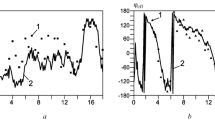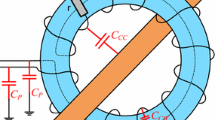Abstract
The open coaxial sensor (OCS) enables online non-destructive testing of a wide range of objects. To solve the electrodynamics problem in the OCS design, this paper puts forward a mathematical model for an OCS with a sample located outside the sensor, and performs the theoretical calibration of the OCS in cylindrical form. The proposed method can be applied to OCSs with different forms of working area. The findings help to develop algorithms and programs for qualitative analysis on OCS features, and to compute the parameters and functions of OCS design. In addition, the analysis method can identify the basic and side effects of the qualitative level, and facilitate the construction of actual OCS designs.


Similar content being viewed by others
References
Shchegoleva T (1996) The study of biological objects in the millimeter range of radio waves. Naukova Dumka, Kyiv, pp 1–182
Liu S, Fu W, He L et al (2017) Distribution of primary additional errors in fractal encoding method. Multimed Tools Appl 76(4):5787–5802
Liu S, Pan Z, Fu W, Cheng X (2017) Fractal generation method based on asymptote family of generalized Mandelbrot set and its application. JNSA 10(3):1148–1161
Liu S, M L, Liu G et al (2017) A novel distance metric: generalized relative entropy. Entropy 19(6):269. https://doi.org/10.3390/e19060269
Hyde MW, Havrilla MJ, Bogle AE (2016) Nondestructive determination of the permittivity tensor of a uniaxial material using a two-port clamped coaxial probe. IEEE T Microw Theory 64(1):239–246. https://doi.org/10.1109/TMTT.2015.2502242
Ivanov VK, Silin AO, Stadnik AM (2011) Definition of complex dielectric permeability of liquids by coaxial probes with the use of substrates from Metaterial Kharkiv. Journal of Radiophysics and Electronics 16(1):91–98
Boybay MS, Ramahi OM (2011) Open-ended coaxial line probes with negative permittivity materials. IEEE Trans Antennas Propag 59(5):1765–1769. https://doi.org/10.1109/TAP.2011.2123056
Detinko MB, Hoptyar CA (1993) Electrodynamic model of microwave resonator with annular measuring hole, loaded on multilayer semiconductor structure. RUSS Phys J+ 9:53–58
Abdelgwad AH, Said TM (2015) Measured dielectric permittivity of chlorinated drinking water in the microwave frequency range. In: Microwave Symposium (MMS) IEEE 15th Mediterranean, pp 1–4. https://doi.org/10.1109/MMS.2015.7375497
Hyde MW, Havrilla MJ (2016) Broadband, nondestructive microwave sensor for characterizing magnetic sheet materials. IEEE Sensors Journal 16(12):4740–4748. https://doi.org/10.1109/JSEN.2016.2548560
Kempin M, Ghasr M, Case J, Zoughi R (2014) Modified waveguide flange for evaluation of stratified composites. IEEE Trans Instrum Meas 63(6):1524–1534. https://doi.org/10.1109/TIM.2013.2291952
Cenanovic A, Schramm M, Schmidt L (2011) Measurement setup for non-destructive complex permittivity determination of solid materials using two coupled coaxial probes. IEEE MTT-S Int Microw Symp Dig:1–4. https://doi.org/10.1109/MWSYM.2011.5972838
Hyde MW, Bogle AE, Havrilla MJ (2014) Nondestructive characterization of PEC-backed materials using the combined measurements of a rectangular waveguide and coaxial probe. IEEE Microw Wireless Compon Lett 24(11):808–810. https://doi.org/10.1109/TMTT.2015.2502242
Hyde MW, Stewart JW, Havrilla MJ, Baker WP, Rothwell EJ, Nyquist DP (2009) Nondestructive electromagnetic material characterization using a dual waveguide probe: a full wave solution. Radio Sci 44:1–13
Yee LK, Hau NW, Kuan CB, Nan PY, Sheng LH, Hock LE (2015) Modeling of microwave elliptical and conical tip sensors for in vivo dielectric measurements RF and microwave. In: Conference (RFM) 2015 IEEE international, pp 222–226. https://doi.org/10.1109/RFM.2015.7587749
Panchenko AY (1998) Modeling a small aperture resonator type microwave meter of substance parameters. Telecommunications and Radio Engineering 52(8):118–121. https://doi.org/10.1615/TelecomRadEng.v52.i8.80
Lu C, Panchenko AY, Slipchenko MI (2016) An integral equation for the field distribution within the aperture plane of the coaxial sensor. Telecommunications and Radio Engineering 75(7):587–594. https://doi.org/10.1615/TelecomRadEng.v75.i7.20
Liu C (2016) Analysis of the properties of the integral equation for the field distribution across the aperture of a coaxial sensor. Telecommunication and Radio Engineering 75(11):969–977. https://doi.org/10.1615/TelecomRadEng.v75.i11.20
Ding G, Wu Q, Zhang L, Lin Y, Tsiftsis TA, Yao YD (2018) An amateur drone surveillance system based on cognitive internet of things. IEEE Commun Mag 56(1):29–35 https://arxiv.org/abs/1711.10738
Xue Z, Wang J, Ding G, Wu Q, Lin Y, Tsiftsis TA (2018) Device-to-device communications underlying UAV-supported social networking. IEEE Access 6(1):34488–34502
Zhang Z, Guo X, Lin Y (2018) Trust management method of D2D communication based on RF fingerprint identification. IEEE Access 6:66082–66087
Tu Y, Lin Y, Wang J et al (2018) Semi-supervised learning with generative adversarial networks on digital signal modulation classification. CMC-Comput Mater Con 55(2):243–254
Lin Y, Li Y, Yin X et al (2018) Multisensor fault diagnosis modeling based on the evidence theory. IEEE Trans Reliab (99):1–9
Sun J, Wang W, Zhang K et al (2018) A multi-focus image fusion algorithm in 5G communications. Multimed Tools Appl (3):1–20
Huang R, Zhang D (2008) Analysis of open-ended coaxial probes by using a two-dimensional finite-difference frequency-domain method. IEEE Trans Instrum Meas 57(5):931–939
Lin Y, Zhu X, Zheng Z et al (2017) The individual identification method of wireless device based on dimensionality reduction and machine learning. J Supercomput 5:1–18. https://doi.org/10.1007/s11227-017-2216-2
Lin Y, Wang C, Wang J, Dou Z (2016) A novel dynamic Spectrum access framework based on reinforcement learning for cognitive radio sensor networks. Sensors 16(10):1–22. https://doi.org/10.3390/s16101675
Wagner N, Schwing M, Scheuermann A (2014) Numerical 3-D FEM and experimental analysis of the open-ended coaxial line technique for microwave dielectric spectroscopy on soil. IEEE Trans Geosci Remote Sens 52(2):880–893
Panchenko AY, Slipchenko MI, Borodkina AN (2014) On the development of a practical technique of theoretical calibration of resonant sensors for near-field microwave diagnostics. Telecommunication and Radio Engineering 73(15):1397–1407
Tang B, Tu Y, Zhang S et al (2018) Digital signal modulation classification with data augmentation using generative adversarial nets in cognitive radio networks. IEEE Access 99:1–1
Ma X, Wang T, Lin Y et al (2018) Parallel iterative inter-carrier interference cancellation in underwater acoustic orthogonal frequency division multiplexing. Wirel Pers Commun 5:1–14
Wang H, Guo L, Dou Z et al (2018) A new method of cognitive signal recognition based on hybrid information entropy and D-S evidence theory. Mobile Netw Appl 4:1–9
Mitra R (1977) Computational methods in electrodynamics. Publishing house Mir, p 485
Panchenko BA (1970) Tenzornye functions of the green equations of Maxwell for cylindrical areas. Radio Engineering 15:82–91
Tai CT (1983) Dyadic Grene's functions for a coaxial line. IEEE T Antenn Propag 48(2):355–358
Hosseini MH, Heidar H, Shams MH (2017) Wideband nondestructive measurement of complex permittivity and permeability using coupled coaxial probes. IEEE Trans Instrumen Meas 66(1):148–157
Mingming W, Liu C, Panchenko AY, Slipchenko MI (2015) Evaluation of influence of microwave radiation sensor in the form of an open end of the coaxial line on its metrological characteristics. Telecommunications and Radio Engineering 74(15):1355–1366. https://doi.org/10.1615/TelecomRadEng.v74.i15.40
Acknowledgments
The work was supported by projects of Heilongjiang Bayi Agricultural University “XDB2014-18” and “NDJY15Z13”.
Author information
Authors and Affiliations
Corresponding author
Additional information
Publisher’s Note
Springer Nature remains neutral with regard to jurisdictional claims in published maps and institutional affiliations.
Rights and permissions
About this article
Cite this article
Chang, L., Panchenko, A., Nikolaevich, B.I. et al. Analysis of the Mathematical Model of Open Coaxial Measuring Microwave Converters. Mobile Netw Appl 25, 1582–1586 (2020). https://doi.org/10.1007/s11036-019-01362-z
Published:
Issue Date:
DOI: https://doi.org/10.1007/s11036-019-01362-z




